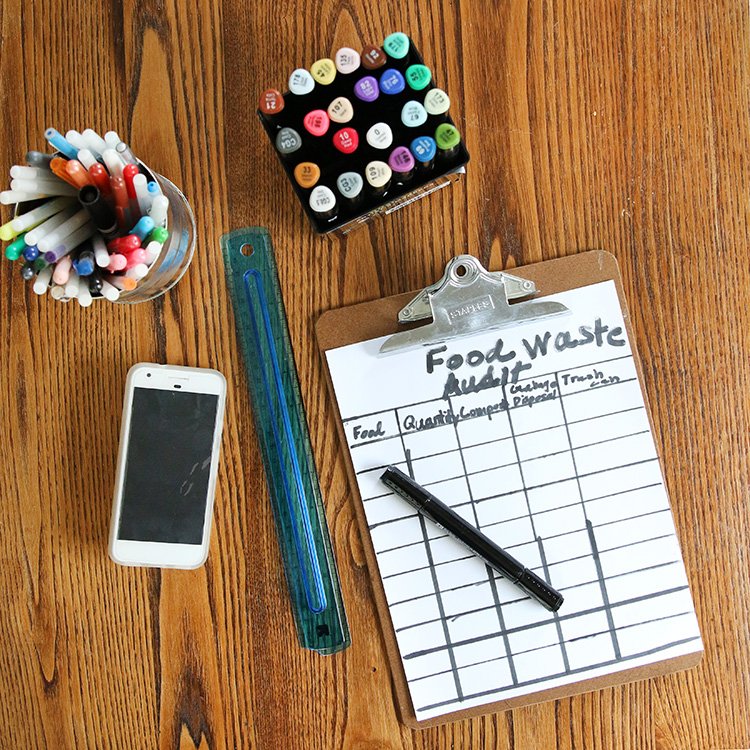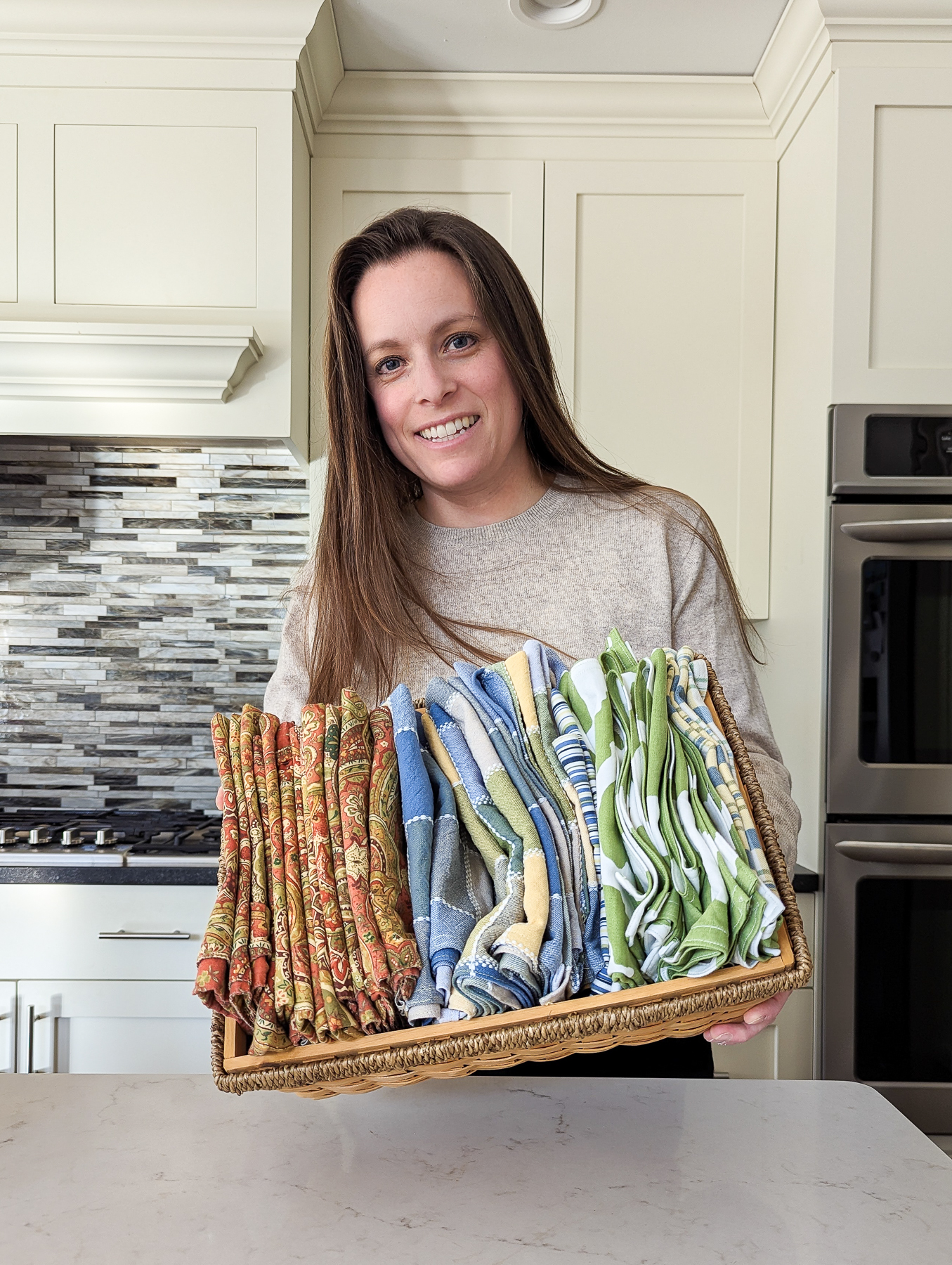How And Why To Do a Food Waste Audit
Have you ever done a food waste audit? You might be surprised by what you learn about how much food you waste, what you waste, and why you waste it. Read on for more information on how to do a food waste audit and what we can learn from it.

Last week, with a bit of prompting from Jess of Thoughtfully Sustainable, we did a week-long food waste audit as a family. My boys created a simple chart to track how much food we wasted. We accounted for any food that could have been eaten or regularly would be eaten, such as leftovers that became stale or perfectly good food that rotted in our fridge or on our counter.
We gained some good insights into the food we wasted. Have you ever tried doing a food waste audit in your home? Do you have any idea about how much and what types of food your family wastes?

Why Care About Food Waste?
Did you know we waste an estimated 40% of our food in the United States? Food is thrown out at various points throughout the supply chain or distribution process.
Produce is left in farm fields for a variety of reasons. Sometimes it’s not the right shape or size, and farmers know it will not be accepted by grocery stores. Other times, the expense of harvesting the crops outweighs the profit farmers will earn by selling them.
Once harvested, certain food does not meet grocery store aesthetic requirements. We literally throw away perfectly wholesome food simply because it is ugly. It won’t look pretty on a grocery store shelf, so we relegate it to the trash.
Grocery stores throw out entire pieces of produce that may only have one small bruise or mark on them because customers refuse to buy them. Consider whether you might overlook an entire carton of eggs because one egg is broken. 11 out of 12 perfectly good eggs in a dozen (or 92% of the food in that package) may be thrown out just because the last egg is cracked.
Grocery stores also trash food that has passed its “best buy” or “sell by” dates, despite the fact that most food is perfectly fine for consumption after these dates. Significant confusion around “best by”, “sell by”, and true “expiration dates” leads to significant food waste at grocery stores and at home.
Individuals also waste a lot of food at home and in restaurants. We plate portions that are too large and leave food on our plates that never gets eaten. We buy items from the grocery store with grand expectations to make fancy dinners or even simple lunches and end up letting too much of that food go bad in our refrigerators and cabinets.
At restaurants, we over-order, leave leftovers at the table, or don’t eat them after we bring them home, and are served excessive portion sizes that we cannot finish.
These are just some examples of where we lose food to the trash. As a community and a country, we waste food through just about every channel at every turning point in the food supply chain.


Why Do A Food Waste Audit at Home
By doing a food waste audit at home, we begin to better understand and notice where and how much food we waste. And food waste is a pretty big deal.
Food waste costs money and resources to produce and transport (all for naught) and unnecessarily fills landfills. Food waste in landfills, where it doesn’t have enough oxygen to properly decompose, creates a potent greenhouse gas called methane that is at least 25 times worse than carbon with respect to global warming. Reducing food waste is a big win for our bank accounts, our communities, and the planet.
For the last year or two, particularly since we started composting and have been more cognizant about food being thrown in the trash or the compost bin, I’ve paid quite a bit of attention to the amount and type of food that we waste. Even through this lens, an intentional food waste audit with a tracking chart held us more accountable, highlighted how much food we wasted, and identified the triggers that typically led to food waste for our family.

How Our Family Did a Food Waste Audit
We started by creating a simple chart to list the following notes about our food waste: Food Item, Quantity, and Where We Disposed It (compost bin, garbage disposal, trash can, etc..). I created a printable chart you can snag if you’re interested. Or you can always make your own as we did. They definitely don’t have to be fancy.
We clipped the piece of paper to a clipboard (just for ease of use) and set it on our counter right near the trash can and compost bin. It could also live on the fridge or a wall that’s easily accessible.
Throughout the week, we each wrote down the food we were personally responsible for wasting. My picky eater wasted the most food, which wasn’t surprising. But writing down what we all wasted as it went in the trash or compost bin gave us insights into the specific mealtimes and food success that led to waste.
Over the course of a week, we wasted the following items at home.
- 1/2 of a naan (it got moldy in the back of our fridge)
- 1 peanut butter sandwich (a snack that never got eaten)
- 1 handful of pretzel goldfish (a school snack that got stale after hiding out in a backpack for too long)
- 1/2 fried egg sandwich (this felt like one of the most difficult waste items to prevent because it doesn’t reheat well and it’s hard to make a smaller portion)
- 1/2 cup smoothie (portion sizes for smoothies are hard to gauge)
- 1/2 cup chocolate pudding (a snack I made that got lost in the back of the fridge)
- 1/2 fried egg sandwich (again…)
- 1/2 peanut butter and jelly sandwich (a school lunch casualty)
- 1/4 bagel with cream cheese (another item that is hard to reheat or save for later when not finished entirely)
- 3 cookies (old ones that got stale while lost in the back of a cabinet)
- 1 piece of pizza (while at a hotel so nowhere to save and reheat)
When we can put food back in the fridge or cabinet, we don’t hesitate to keep even a small portion of leftovers that might be combined with other food to make a full meal. A few extra crackers can go back in the box. Half an apple lasts several days in the fridge in an airtight container and barely turns brown.
Some food though just doesn’t warrant saving, like half a fried egg sandwich. The next day, that sandwich will be gross, at least with my culinary skills. These items commonly found their way onto our food waste list.
Additionally, one night at dinner at a restaurant while out of town for a hockey tournament, we left on the table:
- 1 hotdog and a bun
- 1 cup of French fries
- Broccoli
- Celery
- Carrots
We probably should have finished the veggies. Shame on our health habits for that particular meal. Nonetheless, we only ordered one appetizer, one adult entree, and two kids’ meals for four of us. Yet, we still left so much food on the table!
It’s hard not to waste food while traveling, particularly when we don’t have control over portion size. We typically try to order fewer entrees, which also saves money. But we don’t always know how large portions will be and if we like the food when visiting new restaurants. While traveling, it’s also hard to take leftovers home to a hotel room.


What Our Family Learned From Our Food Waste Audit
For us, the food waste audit was most helpful in showing us which lifestyle habits are more likely to cause food waste for us. Breakfast leaves more food in its wake than dinner. Snacks are a good way to use up leftovers. Meals while traveling are significant food waste sources. And the freezer is a food waste lifesaver.
In hindsight, some of our findings might seem obvious, but I had not paid enough attention in the past to truly isolate the areas where we created the most amount of waste.
Our family has come a long way over the last few years with respect to saving and reusing food so it doesn’t go to waste. I’ve gathered a handful of recipes like soups, stews, and smoothies that help me use up extra bits and pieces of food that are nearing expiration. And we’ve created a family culture and eating habits more focused on scanning the fridge before making new meals and planning grocery lists. Like any family though, some food waste is inevitable.

Have you tried a food waste audit? It’s a fun experiment that can teach us a lot about our habits and help us limit the amount of food we throw in the trash.
Whether or not you’ve done a good audit before, consider downloading the food waste audit tracker or creating your own and trying it (or doing it again). If you try it, be sure to share your comments below or on Instagram. Tag me at @honestlymodern and also tag Jess at @thoughtfullysustainable so we can celebrate with you!
If You Like Food Waste Audits, You Might Also Like
Simple Tips To Reduce Food Waste With Kids
Eco-friendly Crafting: 15 Creative Ways to Use Food Scraps
21 (+71) Ways To Use Up Extra Tomatoes and Reduce Food Waste









